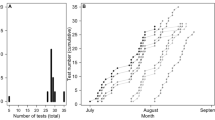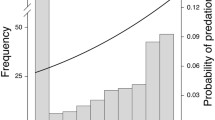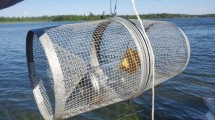Abstract
A behavioral syndrome is a suite of behaviors correlated across multiple social contexts. In this study, boldness in the face of predation risk was assessed twice in fish across two different sensory modalities in both the field and lab to ascertain the biological relevance and complexity of this attribute. Individual fathead minnows were captured from a natural field population using traps that either contained chemical alarm cues (conspecific skin extract) or control (well water) and their responses to the presence of predator behind a glass partition assessed in the laboratory. Although fewer fish were captured in alarm cue-labeled traps, these bold fish performed longer predator inspections than shy fish captured in control traps. Thus, a shy/bold behavioral syndrome was expressed consistently across field and lab settings in response to both chemical and visual indicators of danger. Shy and bold individuals did not differ in sex, body length, secondary sexual characteristics, or parasite load but were of more robust physical condition.



Similar content being viewed by others
References
Bell AM (2005) Differences between individuals and populations of threespined stickleback. J Evol Biol 18:464–473
Bell AM, Stamps JA (2004) The development of behavioural differences between individuals and populations of stickleback. Anim Behav 68:1339–1348
Bell AM, Backstrom T, Huntingford FA, Pottinger TG, Winberg S (2007) Variable behavioral and neuroendocrine responses to ecologically-relevant challenges in sticklebacks. Physiol Behav 91:15–25
Brown GE, Cowan J (2000) Foraging trade-offs and predator inspection in an ostariophysan fish: switching from chemical to visual cues. Behaviour 137:181–196
Brown GE, Godin J-GJ (1999) Who dares, learns: chemical inspection behaviour and acquired predator recognition in a characin. Anim Behav 57:475–481
Brown GE, Paige JA, Godin J-GJ (2000) Chemically mediated predator inspection behaviour in the absence of predator visual cues by a characin fish. Anim Behav 60:315–321
Brown C, Jones F, Braithwaite V (2005) In situ examination of boldness–shyness traits in the tropical poeciliid, Brachyraphis Episcopi. Anim Behav 70:1003–1009
Caro TM (1995) Pursuit-deterrence revisited. TREE 10:500–503
Chivers DP, Smith RJF (1994) Fathead minnows (Pimephales promelas) acquire recognition when alarm substance is associated with the sight of unfamiliar fish. Anim Behav 48:597–605
Chivers DP, Smith RJF (1998) Chemical alarm signalling in aquatic predator–prey systems: a review and prospectus. Écoscience 5:338–352
Chivers DP, Wisenden BD, Smith RJF (1995) The role of experience in the avoidance of darter alarm pheromone by fathead minnows (Pimephales promelas). Behaviour 132:665–674
Coleman K, Wilson DS (1998) Shyness and boldness in pumpkinseed sunfish: individual differences are context-specific. Anim Behav 56:927–936
Danylchuk AJ, Tonn WM (2001) Effects of social structure on reproductive activity in male fathead minnows (Pimephales promelas). Behav Ecol 12:482–489
Dingemanse NJ, Wright J, Kazem AJN, Thomas DK, Hickling R, Dawnay N (2007) Behavioural syndromes differ predictably between 12 populations of three-spined stickleback. J Anim Ecol 76:1128–1138
Dugatkin LA, Godin J-GJ (1992) Prey approaching predators: a cost–benefit perspective. Ann Zool Fennici 29:233–252
Giles N, Huntingford FA (1984) Predation risk and interpopulation variation in anti-predator behaviour in the three-spined stickleback, Gasterosteus aculeatus. Anim Behav 32:264–275
Godin J-GJ, Crossman SL (1994) Hunger-dependent predator inspection and foraging behaviours in the threespine stickleback (Gasterosteus aculeatus) unde predation risk. Behav Ecol Sociobiol 34:359–366
Godin J-GJ, Dugatkin LA (1996) Female mating preference for bold males in the guppy. Poecilia reticulata Proc Nat Acad Sci 93:10262–10267
Huntingford FA (1976) The relationship between anti-predator behaviour and aggression among conspecifics in the three-spined stickleback. Anim Behav 24:245–260
Johnson CJ, Sih A (2007) Fear, food, sex and parental care: a syndrome of boldness in the fishing spider, Dolomedes triton. Anim Behav 74:1131–1138
Lima SL, Dill LM (1990) Behavioural decisions made under the risk of predation: a review and prospectus. Can J Zool 68:619–640
Magnhagen C (1992) Parental care and predation risk in fish. Ann Zool Fennici 29:227–232
Magnhagen C, Borcherding J (2008) Risk-taking behaviour in foraging perch: does predation pressure influence age-specific boldness? Anim Behav 75:509–517
Magurran AE (1986) Predator inspection behaviour in minnow shoals: differences between populations and individuals. Behav Ecol Sociobiol 19:267–273
Magurran AE (1993) Individual differences and alternative behaviours. In: Pitcher TJ (ed) Behaviour of teleost fishes. Chapman and Hall, London, pp 442–477
Magurran AE, Irving PW, Henderson PA (1996) Is there a fish alarm pheromone? A wild study and critique. Proc Roy Soc Lond Ser B 263:1551–1556
Mathis A, Smith RJF (1992) Avoidance of areas marked with a chemical alarm substance by fathead minnows (Pimephales promelas) in a natural habitat. Can J Zool 70:1473–1476
McLeod PG, Huntingford FA (1994) Social rank and predator inspection in sticklebacks. Anim Behav 47:1238–1240
Moretz JA, Martins EP, Robison BD (2007) Behavioral syndromes and the evolution of correlated behavior in zebrafish. Behav Ecol 18:556–562
Pitcher TJ, Green D, Magurran AE (1986) Dicing with death: predator inspection behaviour in minnow shoals. J Fish Biol 28:439–448
Radabaugh DC (1980) Changes in minnow, Pimephales promelas Rafinesque, schooling behaviour associated with infections of brain encysted larvae of the fluke, Ornithodiplostomum ptychocheilus. J Fish Biol 16:621–628
Reaney LT, Backwell PRY (2007) Risk-taking behavior predicts aggression and mating success in a fiddler crab. Behav Ecol 18:521–525
Riechert SE, Hedrick AV (1993) A test for correlations among fitness-linked behavioural traits in the spider, Agelenopsis aperta. Anim Behav 46:669–675
Sandland GJ, Goater CP (2000) Development and intensity dependence of Ornithodiplostomum ptychocheilus metacercariae in fathead minnows (Pimephales promelas). J Parasit 86:1056–1060
Sih A, Bell A, Johnson JC (2004a) Behavioral syndromes: an ecological and evolutionary overview. TREE 19:372–378
Sih A, Bell AM, Johnson JC, Ziemba RE (2004b) Behavioral syndromes: an integrative overview. Q Rev Biol 79:241–277
Verbeek MEM, Drent PJ, Wiepkema PR (1994) Consistent differences in early exploratory behaviour of male great tits. Anim Behav 48:1113–1121
Walling CA, Dawnay N, Kazem AJN, Wright J (2004) Predator inspection behaviour in three-spined sticklebacks (Gasterosteus aculeatus): body size, local predation pressure and cooperation. Behav Ecol Sociobiol 56:164–170
Webster SJ, Lefèbvre L (2000) Problem solving and neophobia in a columbiform–passerine assemblage in Barbadoes. Anim Behav 62:23–32
Wilson DS, Coleman K, Clark AB, Biederman L (1993) Shy-bold continuum in pumpkinseed sunfish (Lepomis gibbosus): an ecological study of a psychological trait. J Comp Psychol 107:250–260
Wilson DS, Clark AB, Coleman K, Dearstyne T (1994) Shyness and boldness in humans and other animals. TREE 9:442–446
Wisenden BD (2003) Chemically-mediated strategies to counter predation. In: Collin SP, Marshall NJ (eds) Sensory processing in the aquatic environment. Springer, New York, pp 236–251
Wisenden BD (2008) Active space of chemical alarm cue in natural fish populations. Behaviour 145:391–407
Wisenden BD, Pohlman SG, Watkin EE (2001) Avoidance of conspecific injury-released chemical cues by free-ranging Gammarus lacustris (Crustacea: Amphipoda). J Chem Ecol 27:1249–1258
Wisenden BD, Rugg ML, Korpi NL, Fuselier LC (2009a) Estimates of active time of chemical alarm cues in a cyprinid fish and an amphipod crustacean. Behaviour (in press)
Wisenden BD, Alemadi SD, Dye TP, Geray K, Hendrickson J, Rud C, Jensen M, Sonstegard G, Malott ML (2009b) Effects of nest substrate on egg deposition and incubation conditions in a natural population of fathead minnows (Pimephales promelas). Can J Zool 87(5):379–387
Acknowledgments
This work was funded by NSF REU grant DBI-0648931 (Field Studies in Global Change at the Headwaters of the Mississippi). We thank Jim and Sehoya Cotner for their help and assistance as well as Itasca and Sorensen laboratories. Two anonymous reviewers provided excellent input.
Author information
Authors and Affiliations
Corresponding author
Additional information
Communicated by T. Bakker
Rights and permissions
About this article
Cite this article
Pellegrini, A.F.A., Wisenden, B.D. & Sorensen, P.W. Bold minnows consistently approach danger in the field and lab in response to either chemical or visual indicators of predation risk. Behav Ecol Sociobiol 64, 381–387 (2010). https://doi.org/10.1007/s00265-009-0854-y
Received:
Revised:
Accepted:
Published:
Issue Date:
DOI: https://doi.org/10.1007/s00265-009-0854-y




